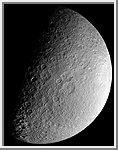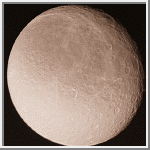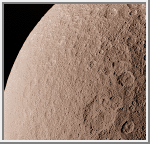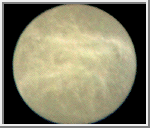











|
Rhea [REE-a] is the largest airless satellite of Saturn. It was discovered in 1672 by Giovanni Cassini. Rhea is an icy body with a density of 1.33 gm/cm3. The low density indicates that it is composed of a rocky core taking up less than one-third of the moon's mass, with the rest composed of water-ice. Rhea is somewhat similar to Dione. They both have similar composition, albedo features, varied terrain and synchronous rotations. The temperature on Rhea is -174°C (-281°F) in direct sunlight and between -200°C and -220°C (-328°F and -364°F) in the shade.
Rhea is heavily cratered with bright wispy markings. Its surface can be divided into two geologically different areas based on crater density. The first area contains craters which are larger than 40 kilometers (25 miles) in diameter. The second area, in parts of the polar and equatorial regions, has craters under 40 kilometers (25 miles) in diameter. This suggests that a major resurfacing event occurred some time during its formation.
| Views of Rhea |
|---|
See also the Rhea Map Image & Rhea Equal-Area Mosaics.
 Rhea - High Resolution Mosaic
Rhea - High Resolution Mosaic
The tracking technique known as "image motion compensation" or IMC was first
used during the Voyager 1 encounter with Saturn for the 10 highest
resolution Rhea images. IMC avoided nine pixels of smear for the 0.48 second
exposures. Without the IMC this mosaic would be seriously blurred due to
high speed of the spacecraft and the resulting image would not look much
different from the bottom part of the mosaic, where a lower resolution wide
angle image is used for the missing part.
IMC was later used successfully by the Voyager 2 spacecraft for nearly all of
the near encounter images at Uranus and Neptune.
(© Copyright A. Tayfun Oner)
 Rhea
Rhea
This image of Rhea was acquired by the Voyager 1 spacecraft on
November 11, 1980.
(Copyright Calvin J. Hamilton)
 Rhea Up Close
Rhea Up Close
This high-resolution view of Rhea shows its heavily cratered crust.
Craters are found within craters. This image was taken by Voyager 1
on November 11, 1980.
(Copyright Calvin J. Hamilton)
 Rhea - Trailing Side
Rhea - Trailing Side
This image of the trailing side of Rhea
shows wispy terrain similar to Dione.
It was taken by Voyager at a range of 1.7 million kilometers.
(Copyright Calvin J. Hamilton)
Copyright © 1997-2000 by Calvin J. Hamilton. All rights reserved. Privacy Statement.